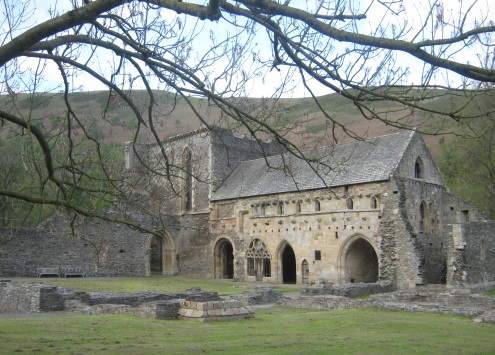
The present-day ruins of Valle Crucis Abbey in Denbighshire: The Abbey Church of the Blessed Virgin Mary, Valle Crucis was founded by a community of twelve Cistercian monks on the site of a temporary wooden church in 1201. It survived a serious fire, the Welsh Wars of King Edward I of England and the Black Death, to grow into a community of around sixty brethren. Sadly, the community was summarily disbanded in the cruel wake of King Henry VIII's dissolution of the monasteries in 1537.
A Forgotten Truth
In his 1919 book The Making of Modern Wales, W. Llewelyn Williams makes an important point about the religious and cultural history of Wales.
He writes: ''Catholicism stood for more than the old religion. It stood also for Welsh nationality. Protestantism was an alien plant fostered by English or Anglicized officials. Men looked back to pre-Reformation days as a time when Wales was not a mere part of England, when the Welsh language was not tabooed in the courts, and when Welsh laws and customs were still observed. All that was best and noblest in Welsh story was intertwined with the history of the roofless abbeys, which remain to this day monuments of Welsh piety and art... Each parish church, called after a native saint who had no place or meaning in the Protestant economy, led the Welsh mind, with its insistence on the living influence of the past, back to the earliest dawn of Christian civilization in the land. Everywhere within sound of the monastic bell had reigned peace and contentment. The Church had given free education to the brightest sons of the poor; it had dispensed its kindly charity in the homes of the aged... With the Reformation came strange doctrines and strange laws. Gone were the kindly landlords of the monastery, and in their place stood needy adventurers, unmindful of the past and uncertain of the future, only anxious to make the most of the present.''
With these words, Llewelyn expressed a truth which has been sadly lost to many in contemporary Wales.
A History That You Can Touch
And yet, it is not too hard to uncover the civilizational foundations of modern Wales; for the whole land remains dotted with ancient monastery ruins and holy wells, still-extant cathedrals and parish churches from the medieval era, Tudor rood-screens and stained-glass windows, plus fascinating place-names that were inspired in ancient times by the names of local Catholic saints and hermits. These were spiritual and cultural heroes, who not only brought the Faith to Wales, but even helped to found the settlements which grew into today's major population centres and kept their names, if not always their memory.
Catholic artefacts abound: it is a remarkable fact that St. Grwst church in Llanrwst (see our recent articles) houses a bell, which is thought to date to the 5th-Century. The archdeacon Giraldus Cambrensis, writing in the 12th-Century, posited that such ancient bells had originated as cattle bells in Ireland and were later adapted by missionaries for ecclesiastical use in Wales.
As we noted recently, it is possible that the Christian faith was retained in the Conwy Valley, even during the darkest days of Pagan England, after the Romans withdrew their local governance from these isles. Certainly, the Faith enjoyed a rapid spread and consolidation in these parts during the 5th to 6th-Centuries; long before the key mission of St. Augustine arrived in Kent in 597 AD. This all means that the old faith was maintained - cultivating and shaping a cultured civilization in Wales - from the earliest recorded times until the destructive rupture of the 16th-Century Reformation.
Perhaps some might accuse the article I posted here on 2nd July last year - highlighting the ancient church of St. Michael the Archangel in Betws-y-coed - of lacking nuance, by suggesting that the church had been ''commandeered for Protestantism''.
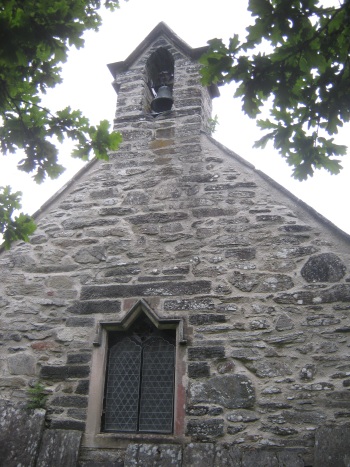
St. Michael's church in Betws-y-coed: Built on the site of an earlier church from the later Celtic era, the present edifice dates to the 14th and 15th-Centuries. In the era of its original foundation, it was common for churches to be named for St. Michael as a symbol of territory being reclaimed from the Devil and for Christ.
And yet, studies like Llewelyn's above, and much more recent research by the likes of Eamon Duffy and others, point us to the fact that the Catholic religion, and the culture which it inspired, did not simply fade away of its own accord; and that neither was the new Protestant religion universally accepted without the whip hand being applied over several decades of social ostricism, fiscal penalty, imprisonment, fearful persecution and outright murder on a sufficiently large scale. Of course many eventually embraced the new religion, but many did not.Â
True Welsh Christianity?
If any today think of Wales' Christian patrimony at all, they likely have in mind the non-conformist culture, which swept the land in waves of enthusiam from the 18th to early 20th-Centuries; overwhelming the still newly-Anglican parish system and eventually issuing forth everywhere in a dizzying myriad of Baptist, Calvinist, Wesleyan and Independent chapels. It is a truth of history, that once union with the Roman Pontiff is lost, division spreads exponentially.
In 1932, H.V. Morton's book In Search of Wales gave an interesting reflection on his visit to the ancient, but now Protestant, church of St. Beuno in Clynnog Fawr. With reference to the non-conformist culture then prevailing, he wrote: ''In a land which worships God in surroundings as severe and practical as those of a town hall, this church in Clynnog Fawr seems unreal and alien... I feel sure the spirits of St. Beuno's monks mock the Welsh Protestants on Sunday, and I am surprised that there is no legend of some night wanderer in Clynnog who, peeping through the now clear windows of the church in the still hours, saw the altar blazing with candles and heard the monks reciting the Little Office of the Blessed Virgin. That is the impression St. Beuno's chapel makes upon me: a haunted church in a land of chapels.''
Perhaps the popular conception of Welsh non-conformism has been less influenced by Morton than it has by Sydney Curnow Vosper's now-classic 1908 depiction of the Salem non-conformist chapel.
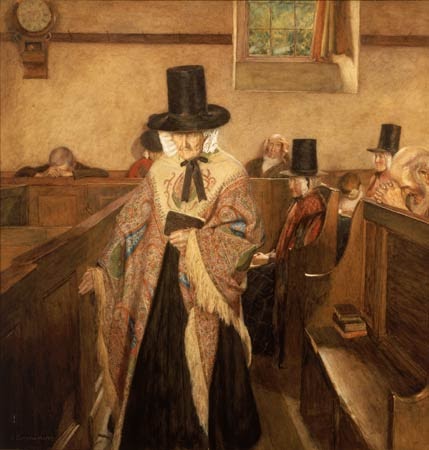
Vosper's painting found an unexpected mass market in the early 20th-Century, when Lever Brothers used it as a promotional image for their popular Sunlight Soap brand. Even when we stayed in an out-of-the-way Snowdonia cottage one year ago, we spotted a print of Vosper's Salem adorning one of the walls in the living area. In Vosper's painting the non-conformist chapel seems a place of colour, warmth and deep piety. But, alas, there is no Real Presence here; and the focus is very much on the stillness of the congregants rather than on the metaphysical drama of the Holy Sacrifice of the Mass, which the Christians of Wales had tragically lost centuries before. Â Â
Losing the Sense of True Joy
In reality, the puritanical atmosphere of Protestantism led to the loss of the ''merry-olde'' conception of religious culture which Catholicism imparted with its colourful cycles of fasting, but also of feasting.
For Catholicism, Sunday is a day of rest from labour, but it is also a day of engagement with Liturgy, prayer, feasting and quality time spent with family and friends.
It was the Calvinistic influences, unleashed by Protestantism, which led to the long-faces and the tying up of swings in parks on Sundays. I sometimes think, and it is a point worth making, that our secularized Western culture is, in some part, a reaction to the false version of Christianity which got loose at the Reformation.
And I further think that the correct, and only life-giving, answer is not the present-day rejection of Christianity; but the rediscovery and subsequent acceptance of full 100% Catholic-Christendom Christianity.
All that being said, the enthusiasms of the 18th-20th Centuries eventually petered out; and the once thriving culture of Welsh non-conformism has now almost died away in this era of universal secularization. Non-conformist chapels, long-since closed, in villages, towns and open country throughout Wales, have been - or else are still in the unsentimental process of being - converted into luxury apartments, holiday homes and business spaces.
Without the fullness of Catholic Truth, the sincere piety of the non-conformists was unable to withstand the driving winds of post-modernity's Neo-Paganism. As we observed last summer, the churches and chapels of Wales stand empty, whilst extreme tattooes and piercings, the occult, and groups of homosexual men acting out in public, are encountered everywhere; from the smallest town to the remotest parts of the countryside.
The widescale decline of Christian civilization in Wales can be generally traced in a line of descent from Catholic Christendom, through Welsh Anglicanism, to chapel-non-conformism and on to today's indifferentist secularism.
In light of the fact that Welsh people are, generally speaking, more open to spirituality than, say, your average pragmatist in post-modern England, one must view the future with a cautious eye. As we have noted the occult is already making a reappearance; and other forms of neo-paganism like the New Age movement are proving as popular in contemporary Wales as in parts of post-Catholic Ireland.
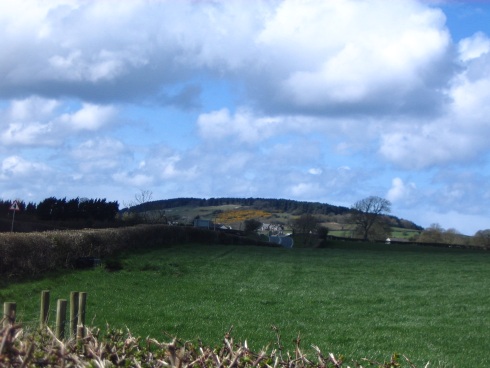
A view across open country to the village in North Wales where we lived from 2007 to 2009. Although there is a modern housing estate on the edge of the old village, the churchyard still contains an original 14th-Century Preachers' Cross. The hill above the village contains an ancient pre-Christian burial mound; which remains a source of superstition to some locals. It is to be feared that, without a concerted re-evangelization, Wales will miss Christ's Cross and turn to new and darker forms of paganism. St. David - pray for us!
Present Trajectories
I read recently, this time in relation to Scotland, that H.V. Morton's playful imaginings of St. Beuno and his monks, would probably need to be revised today in light of the fact that many of the remaining low-Protestant chapels now seem to be more Catholic than the average Novus Ordo parish. The joke suggested that it would now be the Catholics peering in through the windows of the Protestant chapels to see the illumined candles at traditional altars!
In a sense, this is too true to be funny.
Whilst visiting Wales this month, we ventured into a small Catholic parish in one of the towns. Although it is always a comfort to see the veiled Tabernacle, front and centre with the red lamp flickering warmly, it is also something of a shock to the spirit to enter a Novus Ordo parish, and see the versus populum ''peoples' altar'', after having only attended the Traditional Latin Mass for so long. That anthropocentric focus really jars the soul when one has been familiar with an ad orientem religion for so long.
In the parish in question, the sense of spiritual shock was exacerbated by two factors. Firstly, a second, even more versus populum, altar had been introduced, at a much lower level to the first, and as close to the front pews as could be achieved. Secondly, the front of this altar had been emblazoned with a large image of the garish and disturbingly two-headed and three-eyed ''Year of Mercy'' logo.
A section of the pews had been cut away to provide a childrens' classroom area, a rear window ledge had been utilized as a library for secular books, and an advertising board announced a set of local ''mindfulness'' teaching sessions.
In a certain sense this entire set-up seemed expressive of the problems now engulfing and, as if it were possible, threatening to submerge the Universal Church in these difficult times.
Some Diagnosis
When we lived in Wales from 2007 to 2009 we encountered lively pockets of orthodoxy, where priests and people were keen to evangelize and spread the Faith. Some of these places were amazingly fruitful, with great pastoral/prayer work being done in ministering to ''Traveller communities'' and evangelization/healing work amongst locals leading to a small number of people being converted and delivered from hardcore involvement with the occult and enabled to live a new life in Christ through the Sacraments of His Holy Catholic Church.
Still, we also came up against a number of disturbing things. We will briefly consider these here.
1. Destruction of the Sacred Liturgy:Â with priests telling people not to kneel for Holy Communion; lay people claiming it as their right to access the Tabernacle during Holy Mass and then, having been told by the priest to follow the instructions in the GIRM, trying to beat him across the sanctuary to the Tabernacle in order to bring the Hosts out for Holy Communion; large numbers of lay women acting as Extraordinary Ministers of Holy Communion; lay people opening Tabernacles, casually passing around the Ciborium and ''patting'' the Sacred Hosts to ascertain that there were enough for the weekend's Masses; lay people taking Holy Communion to the sick, but stopping off at the supermarket next door, this on a Sunday, and then running through the streets with a Pyx and shopping bag in the same hand. When we tried to correct these distressing abuses, and were completely ignored, we began to travel long distances to get to the Traditional Latin Mass.
2. False Teaching: with people, including religious, promoting things like Reiki, the New Age and Yoga in church settings. Some Welsh citizens who had recently converted from these things found themselves in the disheartening position of having to stand up to priests and well regarded lay people who were promoting them!
3. Indifference: with some folks suggesting that all ''spiritualities'' - even witchcraft - were the same and wanting to practice a syncretic amalgam of Catholicism and Reiki; other folks wanting to turn up for Holy Mass and Holy Communion on the sporadic Sundays that suited them without going to Confession for missing Mass or even seeming to feel any compunction for their actions or approach; a good priest who encouraged us greatly, and who did a lot to reach out in the local community, being harrassed, and I would say bullied, by ''liberal'' clergy and laity who did not want their liberal applecart to be overturned by orthodox Catholicism.
4. Missed Opportunity: When we were in Wales, a job opportunity came up to work in a role promoting marriage in the parishes, youth groups and schools of the diocese. When I discovered that this post would be line-managed by CAFOD, in spite of their troubling response to the condom issue, I decided not to bother applying. Sadly, too little was being done to help young people to hear the true teachings of the Church. Although we were once allowed in to host part of an annual youth retreat in the presence of Bishop Edwin Regan, and a couple of good priests let us do catechetical days, we felt that we had so much more to offer. Â
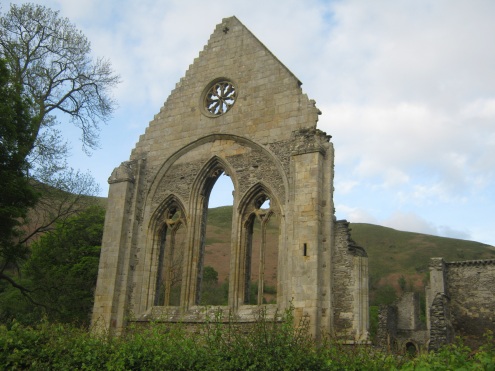
The ruined West Front of Valle Crucis Abbey, complete with this splendid rose window, dates to the 14th-Century. During his 19th-Century architectural endeavours in Wales, George Gilbert Scott stabilized and restored this frontage. Catholicism in Wales is again presenting a sadly crumbling facade. We must pray that it will be similarly stabilized and restored.
Closing 1/3 of Parishes by 2020
When it was announced in July 2012 that Bishop Peter Brignall would be taking over as the new leader of the Diocese of Wrexham, Bishop Edwin Regan expressed his delight with the words: ''He will continue to lead the Diocese in the spirit of the Second Vatican Council.''
We're not sure what exactly His Lordship meant by his use of that somewhat loaded phrase, or if it was a particularly fair assessment of Bishop Brignall or his future endeavours. In any case, since his appointment, we have been positively encouraged by His Lordship's promotion of Eucharistic Adoration and Confession in his diocese.
Still, Catholicism in north Wales was already in a largely moribund state, with plenty of dissent knocking about, by the summer of 2012.
Nobody who cares about souls, or about the health of the Catholic Church, can be truly happy that the Wrexham Diocese recently announced that it will be closing one third - constituting some 22 churches - of its parishes by 2020!
Even after such radical cutting back, the Wrexham Diocese will have just 22 priests below the age of retirement, to continue running the 40 out of today's 62 churches which will still remain in that year.
In his pastoral letter announcing the changes, His Lordship suggested that this was an opportunity for ''renewal'' and asked his priests and people to approach the situation with a generous heart and steadfast faith.
The Living Tradition - The Only Way Forward
In light of all that has been said above, surely it is beyond time for all Catholics who still love God and care about the Church, the salvation of souls and the restoration of society, to recognize that nothing short of a total return to the True Faith, in all its fullness, is going to be necessary. At the very least this will require: a return to the Traditional Latin Mass; 100% Catholic doctrine in teaching and pastoral practice; an authentic living out of the Faith in the midst of caring and outward-looking Catholic communities; and a life of sincere public and private prayer for all practicing Catholics.
We highly regard the work of the Latin Mass Wrexham and the priests and people who make it possible for folks to attend the Traditional Latin Mass at various times of each month. May God bless them for all they do.
If north Wales is to be re-evangelized, it strikes us that a key stategy would be to put people back in touch with the ancient heritage of their Catholic Faith which was first denied to them at the Reformation; and which has been denied them again through the inroads of modernistic dissent into the Catholic Church during recent decades. What could achieve this more effectively than the provision, by Bishop Brignall and his team, of a Traditional Latin Mass parish at a key location in the Diocese?
Such pastoral provision is working very well in dioceses such as Lancaster, Liverpool and Shrewsbury. In the places where orthodoxy is allowed to flourish, there is no shortage of vocations, of commited laity, or of conversions to the Faith.
We sense that the Traditional Latin Mass would be a particular draw to a people who are so spiritually inclined as the Welsh people generally are. Without the awe, beauty, mystery and reverence of the Traditional rite, and the depth of doctrine it so naturally imparts, we fear that more people will fall prey to the spiritualities proffered by the practioners of the occult and the New Age.
When people enter a Catholic Church, it should be so designed and ordered as to strike them at once with the beauty and mystery of Christ's Real Presence. It should not give off the appearance of a lending library, a childrens' classroom or a post-Protestant gathering space.
True Mother of Wales and the Welsh
In the back corner of the Catholic parish in Wales, which I described above, there was a beautiful statue of Our Lady in a deep blue chapel. In that peaceful retreat I sighed aloud: ''O Mother, protect us from all the dreadful Modernism and bring back the old Faith!''Â
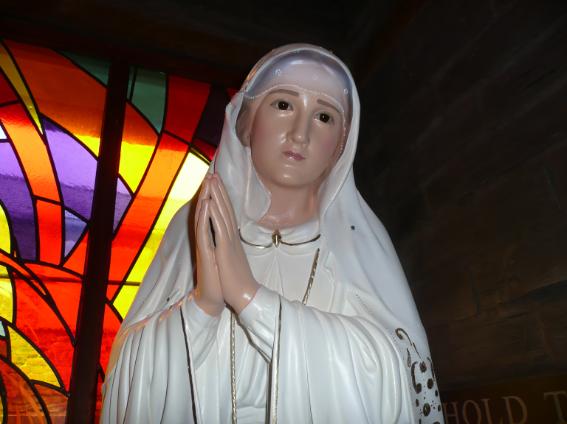
Our Lady of Fatima at the Shrine in Bala: Please note, this is a different parish than the one which is being described here in this article.
In the former Catholic cathedral of St. Asaph in north Wales there is a small ivory statue of the Madonna in a glass-fronted wall-niche. There is a legend that it was taken as booty after the defeat of the Spanish Armada. We sometimes hope that this could be a symbol of Our Lady's final victory in eventually winning back the people of these isles for Christ and His Church in the longer-term.
For we know that Our Lady has such a key role to play in salvation history in general; and in these dark times in particular. Let us pray that She will guide the Church and that the people of Wales will rediscover the True Faith, and the blessing of Our Lord Jesus Christ in Her.
As one of the prayers in the Little Office of the Blessed Virgin has it: Nos cum prole pia benedicat Virgo Maria. This translates as:Â ''May the Virgin Mary, and Her loving Child, bless us! Amen.''Â



